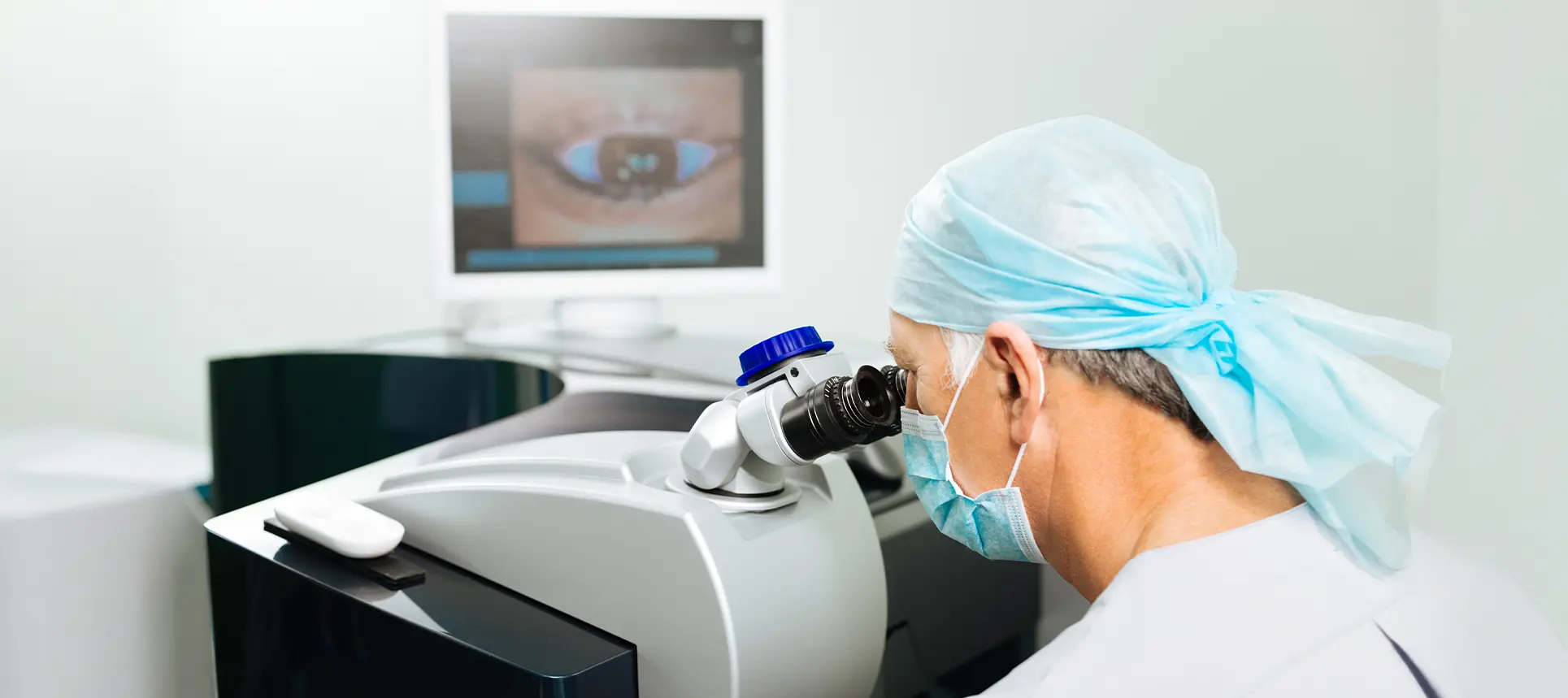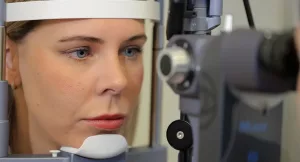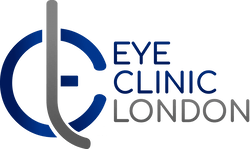How Long Does It Take for Lens Replacement to Settle?

After undergoing refractive lens replacement (RLE), many patients are eager to see the full benefits immediately. The truth is, while your vision often improves quickly, it can take time for your eyes to fully settle and reach their optimal clarity.
In the first few weeks, it’s normal to notice mild blurriness, shifting focus, or changes in light sensitivity. Understanding this settling period, what is normal, and when your best vision typically appears will help you manage expectations and enjoy the results confidently.
What Happens After Lens Replacement Surgery
After your lens replacement surgery, your natural lens is replaced with an artificial intraocular lens (IOL). This new lens helps correct vision problems like presbyopia, hyperopia, or early cataracts so you can enjoy clearer sight without relying as much on glasses or contact lenses. Most people find the settling process smooth and comfortable, with only mild, temporary changes in clarity as their vision adjusts.
Here’s what you can typically expect after the procedure:
- Immediate visual improvement
You’ll likely notice a difference quite soon many people see more clearly within the first 24 to 48 hours. Colours may appear brighter, and your overall vision can feel sharper than before. Don’t worry if things seem a little “too bright” at first; that’s just your eyes adjusting to your new lens. - Gradual stabilisation
Your vision may fluctuate slightly in the first few days or weeks. This is completely normal. Your eyes are adapting to the new intraocular lens, and your brain is learning how to process the improved visual signals. Over time, your sight will become more stable and consistent. - Neural adaptation
It’s not just your eyes doing the work your brain also plays a big role. You’ll go through a process called neural adaptation, where your brain adjusts to the new way your eyes focus and perceive depth. This can take a few weeks, but you’ll gradually find your new vision feels natural and effortless. - Comfort and recovery
You might feel a bit of dryness, mild irritation, or sensitivity to light right after surgery. Using your prescribed eye drops and following your aftercare plan will help you heal comfortably. Most people return to light activities within a couple of days, depending on how their eyes feel. - Follow-up appointments
Your surgeon will schedule check-ups to monitor your healing and ensure your new lens is settling correctly. Attending these appointments is important they allow your doctor to spot any early issues and help you achieve the best visual outcome.
Typical Vision Settling Timeline

Everyone’s recovery after refractive lens exchange (RLE) is slightly different, but your vision generally follows a similar pattern as your eyes heal and adapt. Here’s what you can expect in the weeks and months following surgery:
- First 24–48 Hours
In the first day or two, you’ll probably notice your vision becoming noticeably clearer it’s one of the most exciting parts of recovery.
- Sharpness: You might wake up and realise you can already see more clearly, although a slight blur or haze is normal as your eyes begin to adjust.
- Light sensitivity: Bright lights, reflections, or screens may feel more intense at first. Wearing sunglasses outdoors can make you more comfortable.
- Focus fluctuations: You may find your eyes focusing differently when switching between near and far objects that’s perfectly normal and usually settles with time.
During this early phase, try to take it easy. Avoid rubbing your eyes, heavy lifting, or anything that could strain them. Follow your ophthalmologist’s post-op instructions carefully and use your prescribed eye drops as directed.
- First Week
By the end of your first week, your vision should start to stabilise. Many people feel confident returning to everyday routines, though your eyesight may still fluctuate slightly from day to day.
- You might experience mild dryness or irritation, especially after screen time or reading.
- Your doctor may recommend using lubricating eye drops to keep your eyes comfortable.
- It’s a good idea to take frequent breaks during close-up tasks follow the “20-20-20 rule”: every 20 minutes, look at something 20 feet away for 20 seconds.
Most patients can resume light exercise or desk work at this stage, depending on how comfortable their eyes feel.
- 2–4 Weeks
Over the next few weeks, you’ll likely notice that your vision feels more consistent and natural.
- Clarity improves as your eyes heal and adapt to the intraocular lens (IOL).
- Any lingering halos, glare, or blurriness around lights especially at night tend to fade gradually.
- Follow-up appointments during this stage are key. Your ophthalmologist will check your healing progress, measure your vision, and ensure your new lens is perfectly positioned.
If you experience any unusual discomfort or a sudden change in vision, contact your clinic right away though most people continue improving smoothly at this point.
- 1–3 Months
By now, most people find that their vision has fully settled. You should notice stable, sharp focus for both near and distance tasks, depending on the type of lens you received.
- Your eyes and brain gradually fine-tune depth, clarity, and focus in a process called neural adaptation.
- If you have multifocal or toric lenses, this adjustment period can take a bit longer, but your vision will keep improving with time.
- Only a small number of patients might need minor glasses for very specific tasks, like prolonged reading or night driving.
At this stage, you can usually enjoy the full benefits of your lens replacement clearer, crisper vision with much less dependence on corrective eyewear.
Factors That Affect How Quickly Vision Settles

Several factors influence the settling time after lens replacement:
- Type of Intraocular Lens
- Monofocal lenses: Typically result in faster visual stabilisation.
- Multifocal lenses: Adaptation may take longer as the brain adjusts to multiple focal points.
- Toric lenses: Slight rotational adjustments can influence early vision clarity.
- Age and Neural Plasticity
- Younger patients often adapt faster to new lenses.
- Older patients may experience longer neural adaptation times due to natural changes in the visual system.
- Pre-Existing Eye Conditions
- Conditions like dry eye, glaucoma, or macular degeneration can impact the settling timeline.
- Addressing these conditions before or after surgery helps optimise results.
- Surgical Factors
- The precision of lens placement and surgical technique can affect how quickly vision stabilises.
- Minor adjustments during follow-up visits may be required if alignment or focus is not ideal.
- Lifestyle and Eye Usage
- Prolonged screen time or intense visual tasks immediately after surgery may temporarily affect clarity.
- Gradual resumption of daily activities supports faster adaptation.
What Minor Vision Changes Are Normal
After lens replacement surgery, it’s completely normal to notice a few changes in how you see especially during the first few weeks as your eyes heal and your brain adapts to your new intraocular lenses. These minor fluctuations are usually temporary and tend to improve on their own. Here’s what you might experience:
Halos or Glare
You might see faint rings or halos around lights at night, or notice that glare feels stronger than usual. This is especially common when you’re driving after dark or walking into bright sunlight.
It happens because your eyes are adjusting to how the new lens focuses light. Most people find this effect fades gradually over a few weeks as their vision stabilises. In the meantime, wearing anti-glare or tinted glasses at night can help make you more comfortable.
Slight Blur or Fluctuations in Vision
Your vision may seem a little inconsistent from day to day sometimes clearer, sometimes a bit blurry. This can happen as your eyes fine-tune their focus and the corneal tissue heals.
You might notice it more when switching between tasks, like reading on your phone and then looking into the distance. Don’t worry it’s part of the normal healing process and tends to settle as your eyes adapt.
Near-Far Focus Adjustments
If you’ve received multifocal lenses, your eyes and brain need a bit of time to learn how to focus across different distances. You may notice that reading up close feels slightly strange at first, or that distant objects look clearer than near ones (or vice versa).
This adaptation is known as neural adjustment, and it’s your brain teaching itself how to use your new visual range. With consistent use, your focus at all distances should become smooth and natural.
Light Sensitivity
For a few days after surgery, you might find bright lights, screens, or sunlight a little uncomfortable. This happens because your pupils react more sensitively as your eyes heal.
Wearing sunglasses outdoors, dimming indoor lighting when needed, and avoiding direct glare can make things easier. The sensitivity usually eases within the first week or two.
Mild Dryness or Irritation
Some people also experience mild dryness, a gritty feeling, or occasional watering. This is a normal side effect of the healing process and can slightly affect visual clarity. Using your prescribed lubricating eye drops regularly helps keep your eyes moist and comfortable.
When to Seek Medical Advice
While minor fluctuations are normal, contact your ophthalmologist if you experience:
- Sudden loss of vision or double vision
- Severe or worsening pain
- Persistent flashes, floaters, or halos
- Signs of infection or inflammation
Early intervention ensures safe recovery and optimal results from your refractive lens replacement in London.
Tips to Support Faster Visual Settling
- Follow post-operative instructions: Eye drops, protective eyewear, and activity restrictions help prevent complications.
- Rest your eyes: Limit screen time initially and avoid strenuous visual tasks.
- Protect your eyes: Sunglasses prevent glare and UV damage.
- Attend all follow-up appointments: Your ophthalmologist monitors healing and lens positioning.
- Maintain a healthy lifestyle: Adequate sleep, hydration, and a balanced diet support eye health and healing.
Managing Expectations
When it comes to your vision after lens replacement surgery, it really helps to know what’s normal and what to expect. Understanding how your eyes settle will make the recovery process feel smoother and much less stressful.
Immediate Clarity May Not Be Perfect
You might be excited to see clearly right away, and many people do notice an improvement within the first day or two. But it’s important to remember that your vision may not be completely sharp just yet.
Subtle Fluctuations Are Normal
During the first few weeks, you may find your vision changes slightly from one day to the next. Sometimes things appear brighter or clearer; other times, they might seem softer or less defined.
Patience Is Key
While many people experience stable vision within a few weeks, full visual settling can take up to two or three months. If you’ve received multifocal lenses, it might take a little longer for your brain to completely adjust to focusing at different distances.
Comparing Vision Recovery by Lens Type
How quickly your vision settles after lens replacement can depend on the type of lens you receive. Here’s what you can generally expect:
Monofocal Lenses
If you’ve had a monofocal lens implanted, your eyes usually adapt fairly quickly. These lenses have a single focal point, so most people notice stable vision within 2 to 4 weeks. You may need glasses for certain tasks, like reading, but overall clarity comes quickly.
Multifocal Lenses
Multifocal lenses let you see at both near and far distances, which is amazing but it takes a bit longer for your brain to adjust. Expect your vision to fully settle in 4 to 12 weeks. During this time, you might notice slight fluctuations in focus as your eyes and brain learn to balance multiple focal points.
Toric Lenses
Toric lenses are designed to correct astigmatism, which can make visual recovery a little different. Most people see stable results within 3 to 6 weeks, though minor rotational adjustments may be needed to achieve optimal clarity. Your ophthalmologist will guide you through any fine-tuning if necessary.
Enhancing the Settling Process
Several strategies can support smoother adaptation:
- Gradual reintroduction of reading and computer work
- Regular hydration and proper nutrition for eye health
- Use of artificial tears to manage dryness and reduce visual discomfort
- Avoiding eye strain during the early weeks
These practices complement professional care and promote optimal outcomes.
FAQs About Lens Replacement and Vision Settling:
- How soon will I notice an improvement in my vision after lens replacement surgery?
Most people notice some improvement in clarity within the first 24 to 48 hours after surgery. Colours may appear brighter, and distances may feel sharper almost immediately. However, it’s important to remember that your eyes and brain are still adapting to the new lens, so the initial clarity might fluctuate slightly. Some patients experience mild blur or light sensitivity during these early days, which is completely normal and temporary. - Why does my vision sometimes appear blurry or hazy after surgery?
Blurriness in the early weeks is usually a result of your eyes adjusting to the new intraocular lens and the cornea healing after surgery. Your brain is learning to process the visual signals differently, especially if you received multifocal lenses. This period of adaptation can last a few weeks, and gradual improvements in sharpness should continue until your vision stabilises fully. - Will I experience halos or glare around lights?
Seeing halos or glare, particularly at night or around bright lights, is quite common after lens replacement. These effects occur because your eyes are adjusting to the way the new lens bends and focuses light. In most cases, these visual disturbances diminish over time as your neural adaptation progresses. If halos or glare persist beyond a few months, your ophthalmologist can assess whether any adjustments or solutions are needed. - How long does it take to adjust to multifocal lenses?
Multifocal lenses provide the benefit of seeing at both near and far distances, but they require your brain to adapt to multiple focal points. For most patients, this neural adjustment takes anywhere from four to twelve weeks. During this period, your near or distance vision may feel slightly inconsistent at times, but with continuous use, your brain will gradually learn to interpret the visual information correctly, resulting in smooth focus across all distances. - Are toric lenses different in terms of recovery?
Yes, toric lenses, which correct astigmatism, may involve additional considerations. After surgery, minor rotational adjustments may sometimes be required to achieve optimal clarity. Vision generally stabilises within three to six weeks, but subtle shifts in focus can occur during this period. Your ophthalmologist will monitor the lens alignment during follow-ups to ensure your vision is as sharp as possible. - Can age affect how quickly my vision settles?
Age can influence the speed of visual recovery because neural adaptation tends to be more efficient in younger patients. Older adults may notice that it takes slightly longer for their eyes and brain to adjust to the new lens. However, with patience and adherence to post-operative care instructions, most patients of all ages achieve excellent visual outcomes. - Is light sensitivity normal after lens replacement?
Light sensitivity is a common experience in the first few days following surgery. Your pupils may react more strongly to bright environments, making sunlight, screens, or reflections feel intense. This sensitivity usually improves within a week or two. Wearing sunglasses outdoors, dimming indoor lighting when necessary, and limiting direct glare can make this adjustment period more comfortable. - What should I do if I notice sudden changes in my vision?
While minor fluctuations are normal, sudden changes such as a rapid decrease in clarity, double vision, severe pain, persistent flashes, or floaters should prompt immediate contact with your ophthalmologist. Early intervention helps prevent complications and ensures your eyes continue healing safely. Your surgeon is trained to address these issues promptly and can guide you through any necessary treatment or adjustments. - Can lifestyle choices impact how quickly my vision settles?
Yes, the way you use your eyes and care for your body can influence recovery. Limiting prolonged screen time, avoiding strenuous visual tasks during the first days, staying hydrated, getting adequate sleep, and maintaining a balanced diet all support smoother healing. Following your ophthalmologist’s post-operative instructions consistently also plays a critical role in optimising visual outcomes. - When can I expect my vision to feel completely normal?
For most patients, vision reaches its full potential within two to three months after surgery. Multifocal lenses may take a little longer, as your brain continues to adapt to the new range of focus. During this period, improvements may be gradual, but with proper care and patience, you’ll eventually enjoy stable, sharp vision at both near and far distances with reduced reliance on corrective eyewear.
Final Thoughts: Understanding Lens Settlement After Surgery
After undergoing refractive lens replacement in London, it’s important to remember that your vision doesn’t stabilise instantly. Many patients notice clearer sight within the first 24 to 48 hours, but full visual adaptation can take anywhere from two to twelve weeks, depending on the type of lens you’ve received, your age, and any pre-existing eye conditions.
During this settling period, you may experience minor fluctuations in clarity, occasional halos, or subtle changes in focus. These are normal signs that your eyes and brain are adjusting to your new lenses. By carefully following your post-operative instructions, attending all follow-up appointments, and practising good eye care, you can help ensure your vision settles properly and achieve the best possible outcome.
Patience and realistic expectations are key. The full benefits of refractive lens replacement in London become most apparent once your eyes and brain have completely adapted, giving you clearer, more comfortable vision for the long term. If you’re considering refractive lens replacement in London, you can reach out to us at Eye Clinic London to discuss your options and schedule a consultation.
References:
- Alió, J. L., Plaza-Puche, A. B., Pinero, D. P. & Canto-Corredor, A. (2014) ‘Refractive lens exchange in modern practice: when and how?’, Journal of Refractive Surgery, available at: https://www.ncbi.nlm.nih.gov/pmc/articles/PMC4655463/
- Kotecha, M. R., et al. (2023) ‘Clinical study of functional visual recovery following phacoemulsification with IOL implantation’, available at: https://journals.lww.com/egos/fulltext/2023/16040/clinical_study_of_functional_visual_recovery.6.aspx
- Kaweri, L., Sahoo, N., Paliwal, A. & Gupta, S. (2020) ‘Review of current status of refractive lens exchange and its emerging indications’, International Ophthalmology, available at: https://www.ncbi.nlm.nih.gov/pmc/articles/PMC7856935/
- Hecht, I., et al. (2023) ‘Secondary outcomes of lens and cataract surgery’, available at: https://www.sciencedirect.com/science/article/pii/S1350946222001100
- Yuan, J., et al. (2025) ‘A comparative analysis of visual quality and patient satisfaction following cataract surgery with monofocal and multifocal IOLs’, Eye [online] https://www.sciencedirect.com/science/article/pii/S0011384025001108

